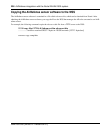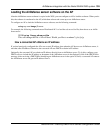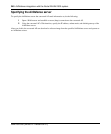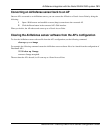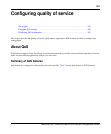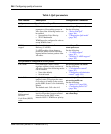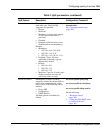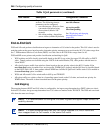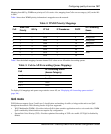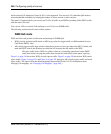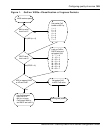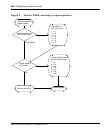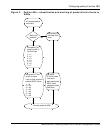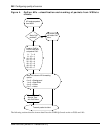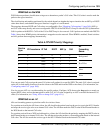
346 Configuring quality of service
NN47250-500 (320657-F Version 02.01)
End-to-End QoS
WSS and APs each perform classification on ingress to determine a CoS value for the packet. This CoS value is used to
mark the packet at the egress interface and to determine priority treatment on egress from the AP. CoS values range from
0 to 7. Differentiated Services Code Point (DSCP) is a 6-bit value in IP-TOS with a range from 0 to 63.
WSS and MP access points each provide classification and marking for QoS:
• WSS switches and APs classify wired traffic based on the 802.1p tag value (for tagged VLAN traffic) or DSCP
value. Tunnel packets are classified using the DSCP of the tunnel header (TH), other packets with the inner or
'client' DSCP.
• APs classify ingress traffic from wireless clients based on the user priority value in the 802.11 header. If the
use-client-dscp option is enabled for a service profile, WMM QoS is ignored, and the QoS level is classified based
on the DSCP value. 802.11 data packets without WMM are classified as QoS level 0 unless static CoS is enabled or
the use-client-dscp option is enabled.
• WSSs and APs mark CoS for wired traffic in 802.1p and TH DSCP.
• APs place traffic to a wireless client in a forwarding queue, based on the CoS value, and mark user priority for
WMM clients. The traffic is then forwarded based on the queue priority.
QoS Mapping
The mapping between DSCP and CoS values is configurable. An ingress map determines how DSCP values are classi-
fied into CoS values. An egress map determines how CoS values are marked in the TH DSCP. The WSS and associated
APs share the same set of maps.
Session timers Keepalives and timeouts for clients
sessions. The following timeout
parameters can be configured:
• user idle timeout—Period a client
can remain idle before being
disassociated (default: 180
seconds)
• idle-client probing—keepalives
sent to clients (enabled by default)
set service-profile
user-idle-timeout
set service-profile
idle-client-probing
See “Displaying and changing
network session timers”
(page 620).
Note. It is recommended to configure the same ingress and egress maps across the
mobility domain.
Note. It is also recommended that any CoS value mapped to a DSCP value and
then mapped back to CoS results in the same CoS value.
Table 1.QoS parameters (continued)
QoS Feature Description Configuration Command



